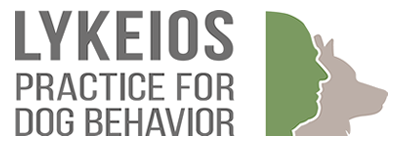
 Handling your dog
Handling your dog
Natural behavior
Learned behavior
Body language
Paying attention exercises
 Lykeios, dog behavior practice
Lykeios, dog behavior practice
Joep de Keyzer
Introduction
This is a guidance to handling our dog. Dealing with our dog, we are following a twofold path: as much as possible we connect with its natural behavior, looking at and learning the social behavior from its ancestor the wolf, and in addition we are teaching him some behavior he does not possess by nature, using knowledge and insights from behavioral theory.
Let us also be aware a dog is first and foremost an animal. Therefore we are doing him justice by treating him like an animal. It is tempting to attribute human characteristics and emotions to a dog, precisely because he is capable to live with us in a harmonious way. He is sharing love and suffering with us and sometimes he is indeed our best friend. Nevertheless, it is good to distance yourself from this emotional approach from time to time and to reduce the dog to what he really is: an animal with ‘lemon brains’ being engaged in only one thing: ‘What is in it for me?” (Jean Donaldson, ‘The Culture Clash’, 1996).
First the natural behavior will be described, starting from the wolf. Subsequently important aspects from the learning theory are covered, which we will apply teaching our dog something. Next the dog’s body language is discussed and finally you will get an instruction about how to practice walking with your dog on a leash.
Deel 1 Natural behavior
Part 2 Learned Behavior
Part 3 Body language
Body postures
Dogs are communicating with each other mainly using body language. When encountering each other it is important to determine the mutual ranking position, being decisive the combination of the tail posture and the position of the ears.
Basically there are four types of body posture to be distinguished indicating the following conditions: self assured/dominant, humble/submissive, ambivalent and scared.
Agression and mimicry
With his mimicry a dog is capable of indicating the degree of aggression, his willingness to attack or not to. In doing so he is pulling up his lips and nose in order to show his teeth and molars. The degree of aggression may vary from dominant aggression through ambivalent aggression to fear aggression.
Conflict signals and tension
With his body language a dog is also able to express having a so called internal conflict. It often occurs when a dog has to do something what he really doesn’t ‘feel like’. It may be related to an unclear ranking position or a dog not understanding or not fully mastering the behavior expected of him. A tension is being built in his body caused by a conflict between two relevant behavioral systems, a tension needing to get out, being achieved by showing behavior not being functional in that situation and at that moment, yawning, shaking and scratching being the most frequent conflict signals. In the behavioral theory this is also known as displacement behavior.
Licking off his mouth is another example of tension. Having a dry mouth, caused by too much adrenalin, a hormone produced under the influence of tension occurring in his body, a dog licks with his tongue along his mouth.
Part 4 Walking at the leash - An exercise in paying attention
Conclusion
All our dogs are descending from the wolf. Whether a Chihuahua, Dachshund, Terrier, Retriever, Poodle, Rottweiler, Shepperd, Husky or a Bastard, all of them have the same behavioral potential as that of a wolf. It is easier to see a Shepperd or a Husky as a wolf than a much smaller dog, but how adorable the latter may seem, he too will behave like a wolf, ‘expecting’ the same from his pack mates.
The education’s starting point is trying to connect with that natural wolf behavior and to behave as often as possible like a wolf our selves dealing with our dog.
Our dogs never reach a mental adulthood, so we have always to be conscious to take a higher position in rank towards him demonstrating the proper related social behavior. This is actually a duty of care towards our dog and there shouldn’t be any exception to this. The German wolf researcher Werner Freund is using the following words to express this: wolves are terribly consequent, among them there exists no ‘Wischi Waschi’.
Next to connecting with his natural behavior, we teach our dog a number of behavioral acts to be deployed at moments our society is needing them. We don’t want our dogs causing other people any nuisance. We cannot and are not allowed to expect other people being as fond of our dogs as we are. In order to achieve this, we are applying the principles from the behavioral science.
This way of educating, connecting as much as possible with the natural behavior and teaching new behavior in order to make our dog properly unction in society, this combination will only benefit the dog’s well being.
When our dog is educated in such a way, I am convinced getting a physically and mentally healthy dog, feeling good about himself, being quiet and relaxed, in short a ‘happy’ dog, who is really a man’s best friend.
Who am I

Joep de Keyzer
- Licensed dog behavioral therapist
- Experienced teacher and coach
- Expert in the field of behavioral science and the dog’s natural behavior
Contact
Having become curious? Having any questions? Or like to make an appointment? Please contact me!
Dog behavioral Practice Lykeios
- Peeskesweg 2, 7041 CB 's Heerenberg
- 06-23914292
- info@lykeios.nl
Vetenerian Clinic de Pijp
- Ceintuurbaan 199, 1074 CV Amsterdam
- 020-26119548
- info@dierenkliniekdepijp.nl
